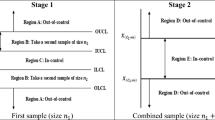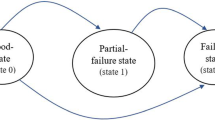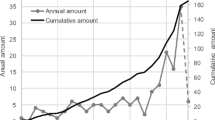Abstract
Remaining useful life (RUL) estimation based on condition monitoring data is central to condition based maintenance (CBM). In the current methods about the Wiener process based RUL estimation, the randomness of the failure threshold has not been studied thoroughly. In this work, by using the truncated normal distribution to model random failure threshold (RFT), an analytical and closed-form RUL distribution based on the current observed data was derived considering the posterior distribution of the drift parameter. Then, the Bayesian method was used to update the prior estimation of failure threshold. To solve the uncertainty of the censored in situ data of failure threshold, the expectation maximization (EM) algorithm is used to calculate the posteriori estimation of failure threshold. Numerical examples show that considering the randomness of the failure threshold and updating the prior information of RFT could improve the accuracy of real time RUL estimation.
Similar content being viewed by others
References
VAIDYA P, RAUSAND M. Remaining useful life, technical health, and life extension [J]. Proceedings of the Institution of Mechanical Engineers Part O: Journal of Risk and Reliability, 2011, 225(2): 219–231.
LORTON A, FOULADIRAD M, GRALL A. Computation of remaining useful life on a physic-based model and impact of a prognosis on the maintenance process [J]. Proceedings of the Institution of Mechanical Engineers, Part O: Journal of Risk and Reliability, 2013, 227(4): 434–449.
BO S, SHENGKUI Z, RUI K, PECHT M G. Benefits and challenges of system prognostics [J]. IEEE Transactions on Reliability, 2012, 61(2): 323–335.
SI X, WANG W, HU C, ZHOU D. Remaining useful life estimation–A review on the statistical data driven approaches [J]. European Journal of Operational Research, 2011, 213(1): 1–14.
CARR M J, WANG W. An approximate algorithm for prognostic modelling using condition monitoring information [J]. European Journal of Operational Research, 2011, 211(1): 90–96.
WANG H, JIANG Y. Performance reliability prediction of complex system based on the condition monitoring information [J]. Mathematical Problems in Engineering, 2013, 2013: 1–7.
WANG X L, JIANG P, GUO B, CHENG Z J. Real-time reliability evaluation based on damaged measurement degradation data [J]. Journal of Central South University, 2012, 19(11): 3162–3169.
SI X, WANG W, HU C H, ZHOU D H, PECHT M G. Remaining useful life estimation based on a nonlinear diffusion degradation process [J]. IEEE Transactions on Reliability, 2012, 61(1): 50–67.
PENG C, TSENG S. Mis-specification analysis of linear degradation models [J]. IEEE Transactions on Reliability, 2009, 58(3): 444–455.
WANG X. Wiener processes with random effects for degradation data [J]. Journal of Multivariate Analysis, 2010, 101(2): 340–351.
TANG S, GUO X, YU C, XUE H, ZHOU Z. Accelerated degradation tests modeling based on the nonlinear Wiener process with random effects [J]. Mathematical Problems in Engineering, 2014, 2014: 1–11.
WANG W, CARR M, XU W, KOBBACY K. A model for residual life prediction based on Brownian motion with an adaptive drift [J]. Microelectronics Reliability, 2011, 51(2): 285–293.
YE Z, TSUI K L, WANG Y, PECHT M G. Degradation data analysis using wiener processes with measurement errors [J]. IEEE Transactions on Reliability, 2013, 62(4): 772–780.
TANG S, YU C, WANG X, GUO X, SI X. Remaining useful life prediction of Lithium-ion batteries based on the Wiener process with measurement error [J]. Energies, 2014, 7(2): 520–547.
TANG S, GUO X, ZHOU Z. Mis-specification analysis of linear Wiener process–based degradation models for the remaining useful life estimation [J]. Proceedings of the Institution of Mechanical Engineers, Part O: Journal of Risk and Reliability, 2014, 228(5): 478–487.
YE Z, SHEN Y, XIE M. Degradation-based burn-in with preventive maintenance [J]. European Journal of Operational Research, 2012, 221(2): 360–367.
GEBRAEEL N Z, LAWLEY M A, LI R, RYAN J K. Residual-life distributions from component degradation signals: A Bayesian approach [J]. IIE Transactions, 2005, 37(6): 543–557.
YE Z, CHEN N, TSUI K L. A Bayesian approach to condition monitoring with imperfect inspections [J]. Quality and Reliability Engineering International, 2015, 31(3): 513–522.
WANG X, GUO B, CHENG Z. Residual life estimation based on bivariate Wiener degradation process with time-scale transformations [J]. Journal of Statistical Computation and Simulation, 2012, 84(3): 1–19.
SI X, WANG W, HU C, ZHOU D. Remaining useful life estimation–A review on the statistical data driven approaches [J]. European Journal of Operational Research, 2011, 213(1): 1–14.
WANG X, JIANG P, GUO B, CHENG Z. Real-time reliability evaluation with a general wiener process-based degradation model [J]. Quality and Reliability Engineering International, 2014, 30(2): 205–220.
TANG S, GUO X, YU C, ZHOU Z, ZHOU Z, ZHANG B. Real time remaining useful life prediction based on nonlinear Wiener based degradation processes with measurement errors [J]. Journal of Central South University, 2014, 21(12): 4590–4517.
WANG X, BALAKRISHNAN N, GUO B. Residual life estimation based on a generalized Wiener degradation process [J]. Reliability Engineering & System Safety, 2014, 124: 13–23.
XU Z, JI Y, ZHOU D. Real-time reliability prediction for a dynamic system based on the hidden degradation process identification [J]. IEEE Transactions on Reliability, 2008, 57(2): 230–242.
FENG L, WANG H, SI X, ZOU H. A State-space-based prognostic model for hidden and age-dependent nonlinear degradation process [J]. IEEE Transactions on Automation Science and Engineering, 2013, (10)4: 1072–1086.
WANG X, GUO B, CHENG Z, JIANG P. Residual life estimation based on bivariate Wiener degradation process with measurement errors [J]. Journal of Central South University, 2013, 20(7): 1844–1851.
WANG P, COIT D W. Reliability and degradation modeling with random or uncertain failure threshold [C]// Proceedings of the Reliability and Maintainability Symposium, 2007 RAMS '07 Annual. Orlando, FL: IEEE, 2007: 392–397.
WANG W. A two-stage prognosis model in condition based maintenance [J]. European Journal of Operational Research, 2007, 182(3): 1177–1187.
WEI M, CHEN M, ZHOU D. Multi-sensor information based remaining useful life prediction with anticipated performance [J]. IEEE Transactions on Reliability, 2013, 62(1): 183–198.
ZIO E, COMPARE M. Evaluating maintenance policies by quantitative modeling and analysis [J]. Reliability Engineering & System Safety, 2013, 109: 53–65.
USYNIN A, HINES J W, URMANOV A. Uncertain failure thresholds in cumulative damage models [C]// Proceedings of the Reliability and Maintainability Symposium, 2008 RAMS 2008 Annual. Las Vegas: IEEE, 2008: 334–340.
JIANG R, JARDINE A K S. Health state evaluation of an item: A general framework and graphical representation [J]. Reliability Engineering & System Safety, 2008, 93(1): 89–99.
JIANG R. A multivariate CBM model with a random and time-dependent failure threshold [J]. Reliability Engineering & System Safety, 2013, 119: 178–185.
GREENE W H. Econometric analysis [M]. 5th Ed, Upper Saddle River. New Jersey: Prentice Hall, 2003: 756–760.
FOLKS J L, CHHIKARA R S. The inverse gaussian distribution and its statistical application-A review [J]. Journal of the Royal Statistical Society Series B: Methodological, 1978, 40(3): 263–289.
SI X, WANG W, CHEN M, HU C, ZHOU D. A degradation path-dependent approach for remaining useful life estimation with an exact and closed-form solution [J]. European Journal of Operational Research, 2013, 226(1): 53–66.
SI X, WANG W, HU C, CHEN M, ZHOU D. A Wiener-processbased degradation model with a recursive filter algorithm for remaining useful life estimation [J]. Mechanical Systems and Signal Processing, 2013, 35(1/2): 219–237.
ZHOU Z, HU C, YANG J, XU D, ZHOU D. Online updating belief-rule-base using the RIMER approach [J]. IEEE Transactions on Systems, Man and Cybernetics, Part A: Systems and Humans, 2011, 41(6): 1225–1243.
YOU M, LIU F, WANG W, MENG G. Statistically planned and individually improved predictive maintenance management for continuously monitored degrading systems [J]. IEEE Transactions on Reliability, 2010, 59(4): 744–753.
CADINI F, ZIO E, AVRAM D. Model-based Monte Carlo state estimation for condition-based component replacement [J]. Reliability Engineering & System Safety, 2009, 94(3): 752–758.
CURCURÙ G, GALANTE G, LOMBARDO A. A predictive maintenance policy with imperfect monitoring [J]. Reliability Engineering & System Safety, 2010, 95(9): 989–997.
DEMPSTER A P, LAIRD N M, RUBIN D B. Maximum likelihood from incomplete data via the EM algorithm [J]. Journal of the Royal Statistical Society Series B: Methodological, 1977, 39(1): 1–38.
YE Z, NG H K T. On analysis of incomplete field failure data [J]. The Annals of Applied Statistics, 2014, 8(3): 1713–1727.
Author information
Authors and Affiliations
Corresponding author
Additional information
Foundation item: Projects(51475462, 61174030, 61473094, 61374126) supported by the National Natural Science Foundation of China
Rights and permissions
About this article
Cite this article
Tang, Sj., Yu, Cq., Feng, Yb. et al. Remaining useful life estimation based on Wiener degradation processes with random failure threshold. J. Cent. South Univ. 23, 2230–2241 (2016). https://doi.org/10.1007/s11771-016-3281-z
Received:
Accepted:
Published:
Issue Date:
DOI: https://doi.org/10.1007/s11771-016-3281-z




